Archive for November 2006
Flushed away for real?
Kristin here–
Coincidentally, the day before I was planning to see Flushed Away, the latest feature from the brilliant English animation studio, the new Variety arrived with a relevant story. “An Aard-Knock Life,” reveals that “After the second commercial disappointment in as many years from the quirky British claymation studio, insiders say DreamWorks Animation is unlikely to put any more Aardman toons on its sked. Instead, the Blighty company is believed to be looking for a new theatrical partner—likely one that doesn’t have ‘Shrek’-sized expectations for its releases.”
If that happens, maybe Aardman should also make sure that its next studio knows how to sell a movie.
The first “disappointment” for DreamWorks was Wallace & Gromit in the Curse of the Were-Rabbit. That film was so disappointing that it won the 2005 Oscar as best animated feature and was a hit virtually everywhere in the world except the USA.
I’m irresistibly reminded of Disney/Buena Vista’s releases of a few films by Hayao Miyazaki. Not really knowing what to do with these complex, poetic masterpieces, they essentially gave up on the first, Princess Mononoke (American release, 1997), doing almost nothing to publicize it and letting it play to nearly empty theaters in a relatively limited release. Spirited Away (2001) got a lackluster release from Disney, who at least had the decency to make both dubbed and subtitled prints available. Once the movie won the 2002 animated-feature Oscar, the studio gave it a half-hearted re-release. Howl’s Moving Castle (dubbed, 2005) must have gotten most of its business as a result of sterling reviews rather than publicity.
One thing DreamWorks and Disney have in common in these cases: both of them seem not to have noticed that they didn’t make these films. That does matter when you’re trying to find an audience for them.
You could argue that three of the greatest sources of animation, at least theatrical feature-length animation, are Pixar, Aardman, and Studio Ghibli, Miyazaki’s company. (On this level of brilliance, it’s hard to choose among them.) Buena Vista distributes both Pixar and Ghibli films. Pixar films clean up at the box office; Ghibli films pick up rave reviews and awards. (Outside North America they set box-office records.) Distributing Aardman films has been an iffy undertaking for DreamWorks. Chicken Run succeeded, Curse of the Wererabbit didn’t, and, if Variety is right, DreamWorks hopes for no better from Flushed Away.
Why the disparity, when these three studios have walked off with the past four best animated picture Oscars? I’d suggest it’s because Disney and DreamWorks have made no attempt to make their imported films into recognizable brands. They sell them as if they were their own products. Then they wonder why people are mystified when they see “Disney’s” Spirited Away or “DreamWork’s” Flushed Away and find that these films are not what they’re used to from those studios.
Pixar, on the other hand, succeeds in the U.S. partly because it’s a brand. These aren’t Disney films, they’re Pixar films, with the cute little lamp that jumps around in the logo. Even now that Pixar has been bought by Disney, you can bet that the films will go out under the name “Pixar” and have that little lamp.
Disney has never really tried to establish Ghibli as a brand. I think Miyazaki’s films are awkward for the American market. They’e too grown up for the kids who usually go to animated features, too much “cartoons” for adults. Still, given Miyazaki’s reputation—the reviews, the awards, the success in other markets—I suspect Disney could succeed by stressing the Ghibli name and reputation and marketing them as art-house films. They get trampled in the multiplexes.
Similarly, DreamWorks keeps trying to market Aardman films as DreamWorks films. Flushed Away is, according to the ads, “From the creators of Shrek and Madagascar.” If you lure people into the theaters with that claim, of course they’re going to be baffled when they get sophisticated, witty tales instead of broad, obvious comedy. (I enjoyed Shrek, but it’s been considerably overrated. That it rather than Monsters Inc. should have won the first best animated feature Oscar shows why hype and box office can do.)
If DreamWorks instead had made any effort to make Aardman into a brand as recognizable here as in Britain (well, nearly as recognizable), these films would undoubtedly have a bigger success here in the States. Releasing the three Wallace & Gromit shorts as a feature-length program, as was done in Europe, could have won a devoted following for them and things Aardman. Such a release would have cost very little and could have prepared the way for Curse of the Wererabbit and others.
So, back to Flushed Away and its supposed failure. From my reading of the box-office figures over the mere 12 days the film has been in release, it looks like a moderate success. If DreamWorks is ready to write it off already, then Hollywood really has become so focused on opening-weekend grosses as to be blinkered to all other indicators.
As everyone noted, when Flushed Away opened on November 3, it split the family audience with The Santa Clause 3: The Escape Clause. With Borat’s “surprise” success (a surprise only to Twentieth Century Fox and a few pundits), taking in $26 million in 827 theaters and grabbing the Monday infotainment coverage, the Santa Clause came in second at $19, 504,038 and Flushed Away a close third at $18,814,323. After 12 days, those two are still bringing in similar grosses: Santa Clause totaling $42,312,847 and Flushed Away $41,017,254.
But, as I suggested in my piece on Borat, the top three films of the November 3 weekend looked like they would have legs and hold up remarkably well on their second weekend. Sure enough, Santa Clause dropped off a mere 13.2% and Flushed Away only 11.7%. These days, a drop-off of significantly below 50% on the second weekend is considered good. These two drop-offs are very, very low.
If DreamWorks can accept a modest success rather than a Shrek-size result, they may emphasize Flushed Away as a hit, let it play through the holidays, and see what happens when kids are out of school.
DreamWorks also might look at its own history with Aardman. Chicken Run’s opening weekend gross was $17,506,162. (Given inflation, that’s probably comparable to Flushed Away’s opening). Its domestic total was $106,843,564. Not a smash, but good enough to put it twentieth on the box-office chart for that year. Moreover, Chicken Run’s opening weekend was 16.4% of its eventual domestic gross. These days some films take in half their total on the first weekend. Let’s compare it with another long-legged film. The Fellowship of the Ring (a December 2001 release which was still in theaters in August 2002, two weeks after its DVD came out), made 15.1% of its domestic gross during its opening weekend.
Maybe DreamWorks is doing what I suggested not to do: looking on Monday morning at what won the horse race and jumping to conclusions.
So, what did I think of Flushed Away? I thoroughly enjoyed it. I kind of miss the thumbprints you could sometimes spot in the clay of previous Aardman films, but otherwise this first venture into CGI looks very similar. (The studio says they went to CGI in order to make the many water effects seem realistic.) Like the Pixar features and other Aardman films, it has a clear, tight storyline structured around goals, the primary one being that of the hero, a pet mouse, trying to get home after being flushed down the toilet to the sewers.
The world under London’s pavement is dense with the usual clever references and puns and bizarre characters that populate Aardman’s features. More so than usual, in fact: a whole city full of shops, advertisements, and miniature objects that have been put to new uses. In fact, there’s so much to see that I frequently felt the pace was too fast, whipping you past sets before you could do more than glimpse the details. The references to other films, from Finding Nemo to The Two Towers, come thick and fast.
The movie also benefits from the trend of recent years toward all-star vocal casts in animated films. With Hugh Jackman for the hero, Kate Winslet for the heroine, and Ian McKellen for the main villain, the characterizations are wonderful.
And as for the singing chorus of slugs that wanders through the film … well, it has to be seen and heard to be believed. As with other Aardman films, stick around for the credits.
Cutting remarks: On THE GOOD GERMAN, classical style, and the Police Tactical Unit
DB herer:
For about ten days Kristin and I are off the grid, unable to check email, let alone blog.
In the meantime we’ll backlog some blogs (backblogs) to be posted at intervals. When we get back, we’ll probably divulge where we went.
This is a followup to my entry on The Good German of some days back. I want to talk a bit about editing technique in classical and contemporary film.
Recall that Dave Kehr’s fine reportage on Soderbergh’s Good German appeared in the New York Times. The film is set in postwar Berlin during the late 1940s, and Soderbergh is trying to film it with the production procedures of the time. He’s using boom microphones and incandescent lights, and he’s asking actors to deliver the lines in the forthright manner characteristic of classic studio acting. He’s using prime lenses of fixed focal length (as opposed to today’s zoom lenses with minutely adjustable focal length). Those prime lenses will often be wide-angle ones (e.g., 32mm), the sort that Soderbergh discovered that Michael Curtiz employed at Warners.
Soderbergh will also avoid multiple-camera shooting, which is common for most scenes nowadays; he will shoot single-camera. This has fascinating implications for staging and editing choices. Dave Kehr explains:
If there is a single word that sums up the difference between filmmaking at the middle of the 20th century and the filmmaking of today, it is “coverage.” Derived from television, it refers to the increasingly common practice of using multiple cameras for a scene (just as television would cover a football game) and having the actors run through a complete sequence in a few different registers. The lighting tends to be bright and diffused, without shadows, which makes it easier for the different cameras to capture matching images.
The advantage for directors is that they no longer need to make hard and fast decisions about where the camera will go for a particular scene or how the performances will be pitched. The idea is to pump as much coverage as possible into the editing room, where the final decisions about what goes where will be made.
The danger for a director is that with so much material available, the original vision may be drowned or never really defined; and the sheer amount of exposed film makes it possible for executives to step in (after the director has completed his union-mandated first cut) and rearrange the material to follow the latest market-research reports.
During the studio era it was more typical for directors to arrive on the set, block out their shots and light them with the use of stand-ins; the actors were then summoned from their dressing rooms and, after a brief rehearsal, they would film the lines needed in the individual shot. The crew would then break down the camera and move it to the next setup, as determined by the director.
“That kind of staging is a lost art,” Mr. Soderbergh said, “which is too bad. The reason they no longer work that way is because it means making choices, real choices, and sticking to them. It means shooting things in a way that basically only cut together in one order. That’s not what people do now. They want all the options they can get in the editing room.”
While the editing process now routinely takes months, “I had a pretty polished cut of ‘The Good German’ two days after we wrapped,” Mr. Soderbergh said. “It was shot to go together very, very specifically.”
Let’s start with the concept of coverage.
Shooting to Protect
Consider a traditional conversation scene.
In the classical Hollywood style, most such scenes were shot with a single camera. (In the silent years, big films would be shot with a second camera to provide a negative for foreign markets. This means that in some films, the overseas versions were slightly different, shot for shot, from their US counterparts.)
Your conversation scene will be edited. So how do you film it? Working with only one camera, directors developed procedures for “covering” a scene.
Here’s the default. The entire scene would be played out in a single, distant take, usually called the master shot (sometimes “master scene”–for a long time, filmmakers confusingly called shots “scenes”). The master shot provided an uninterrupted record of the whole scene, and thus served as a reference point for overall set geography, where actors were standing, and so on.
Once the master shot was finished, the filmmakers went on to break the scene down into closer positions. That meant repeating portions of the scene already played in the master. They shot the medium two-shots of the actors talking, the shots of each actor taken from over the shoulder of the other actor, the singles of each player–which might be medium-shots, medium close-ups, or close-ups.
(Sometimes the filmmakers also shot inserts, the detail shots of objects or printed matter that would be inserted into the action, but usually they were filmed another time, or by an entirely different crew under the supervision of an assistant or second-unit director. Often the hands we see in an insert close-up aren’t those of the actor.)
For each different camera position, the actor would have to repeat the relevant bit of dialogue, gesture, or whatever that had already been played out in the master. Must have gotten boring, no?
The question arises: How much coverage do you shoot? Do you have to film from all those angles, and do you have to repeat everything to the max?
One answer says yes. Overshoot. This is the shoot and protect option. Film lots more footage than you can possibly ever use. Film is cheap, and you want lots of options in the editing room. Since in the studio system, directors rarely supervised the editing of their films, the editor worked with the producer, and the producer wanted to readjust the film in the cutting phase–inserting a close-up of the star, tightening the pace, and so on.
Shoot and protect is an insurance policy, and producers still insist on it. In The Way Hollywood Tells It, I quote Swedish cinematographer Sven Nykvist’s remark that American directors shot a lot more coverage than European ones. “I believe that comes from the fact that producers usually have the final cut and they want to have all the material they can get.” In the studio era, producers might want changes and demand reshoots of portions of scenes so the sequence would cut together better.
During the studio era, the most famous director who relied on overshooting is George Stevens. In an interview with Kristin and me, William Hornbeck talked about how Stevens was maniacal about reshooting the scene from every angle he could think of. Then he would run the footage over and over, trying to decide what takes to use. One result of this is a fairly choppy style. The barroom fight in Shane is almost wholly created in the editing room, and some of the cuts are downright clumsy.
Or take the barbecue scene of Giant, where the cuts struggle to extract a throughline of action. Elizabeth Taylor stands on the edge of the crowd, and abruptly Stevens dissolves to an extreme long shot of the festivities.

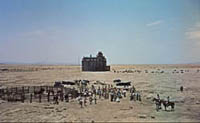
So is the scene ending, as such a reestablishing shot might suggest? No, because we dissolve again to her, now walking to the tree in the foreground, captured in a high angle from a crane.
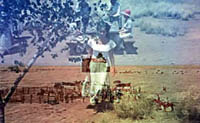
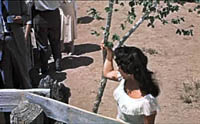
Most directors would have moved Elizabeth Taylor away from the crowd in a single tracking shot, letting the camera follow her approach to the tree. Stevens apparently hadn’t planned or filmed such a shot, so he had to use two dissolves, although there doesn’t seem to be a time lapse. Once Liz gets to the tree, the high angle obscures her face and gesture, so a cut tries to clarify:
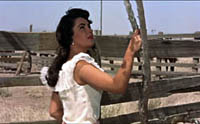
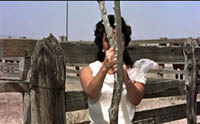
Stevens cuts to a head-on shot of her starting to swing around the tree. But she doesn’t get a chance to complete this gesture because the tree blocks her face and arms. So Stevens cuts away to James Dean, already walking leftward to the car–another interrupted action.
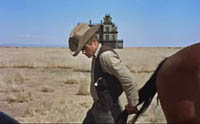
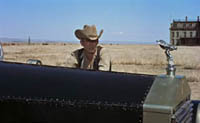
Dean settles down to watch the barbecue from a distance, but instead of getting anything resembling a point-of-view shot, we go back to the uninformative high angle, in which a cowpoke offers Taylor a drink.
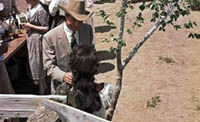
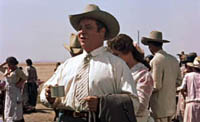
We can’t really see the first man’s gesture, or her reaction, so the dialogue has to carry the whole scene. And this action is interrupted again by another man proposing a toast to the couple. The high angle adds nothing to the scene. Didn’t Stevens film this bit of action from a more straightforward setup? If not, maybe he didn’t protect himself. Whatever happened, this passage seems to be very awkward filmmaking.
Granted, the cuts between Taylor and Dean do parallel them as outsiders and prefigure their alliance later in the film. But the same points could be made with smoother cuts and greater integrity of gesture. The scene’s fragmentation prefigures today’s interruptive editing.
Someone might argue that the jumpy cutting conveys something expressive about the scene (maybe Taylor’s anxiety about making a mistake in front of her new husband’s friends). But this is an all-purpose alibi, which can be invoked to defend any case of poor craftsmanship. My shot’s out of focus because…um…the hero’s uncertain of his identity. Moreover, if we defend the cutting as projecting Taylor’s anxiety, we’re tacitly granting that the scene has failed to convey that through performance, staging, and other techniques.
Lest it seem I’m being too mean to Stevens, I’ll just point out that occasionally he took some chances, even using single-shot high-angle staging reminiscent of Mizoguchi. Here’s an example from A Place in the Sun.
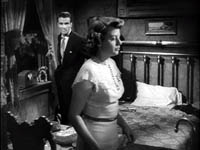
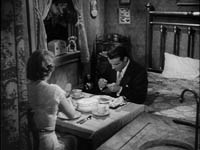
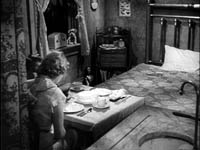
Shooting Cut to Cut
“Shooting for protection” sounds a bit defensive and wussy, like you’re afraid to make a choice. Suppose you try another tactic. Suppose you shoot only what you think you will finally cut together.
You might still shoot the master shot for insurance, but maybe not. On the whole, you’d shoot only the angles you’d decided on in advance, or perhaps you would add a few pieces for protection. Basically there would be only one way to cut the scene together. This was called filming “cut to cut” or “cutting in the camera.”
Hitchcock is the most famous exponent of this tactic, thanks largely to his claims that he preplanned everything that appeared on screen. After working out the script, shot lists, and storyboards, he knew exactly what he wanted, he said, and so the actual filming was a little tedious. I think he once remarked that he wished he could phone a film in. In truth, Sir Alfred exaggerated the precision of his planning. Bill Krohn’s excellent book Hitchcock at Work debunks “the myth of the storyboard” (which were often made after filming, to show reporters) and Krohn offers several examples of set improvisation, last-minute changes, tightening during editing, and so on (pp. 9-16). Nevertheless, on the whole Hitch probably shot significantly less coverage than most directors.
So too, evidently, did John Ford. Ford didn’t pre-plan his films to the minute degree Hitchcock claimed, but he achieved enough power in the system to avoid the shoot-and-protect method. According to editor Elmo Williams, whom I once asked about this, Ford had the reputation of giving his cutters almost no range of setups to choose from. If you give ’em a close-up, he supposedly said, they’ll use it. Ford apparently kept track of all the shots he wanted in his head, which may explain some of the mismatches that we find in his films. But it did mean that when the shooting was finished, he could hand the footage over to an editor and go out on his boat.
Another director who filmed coverage sparingly was W. S. Van Dyke, known as Wun-Shot Woody. You can read more about him here.
So there are degrees of coverage, from the maximal coverage of shoot-and-protect to the minimalism of cutting in the camera. Of course you can avoid coverage altogether by shooting your scene in a single take, from a single position (as Hou Hsiao-hsien often does) or with a moving camera. Producers hate this. Christine Vachon calls it “a ‘macho’ style that leaves no way of changing pacing or helping unsteady performances” (The Way Hollywood Tells It, 153). The director who doesn’t provide extensive coverage is a producer’s nightmare.
Camera A + Camera B + Camera C…+Camera N = ?
What about shooting the scene with more than one camera? Before the 1970s, multiple cameras were used chiefly for action sequences, and especially for things that couldn’t be repeated, like an explosion or cars hurtling off a cliff. Multiple cameras were also used for a brief period when sound first came in; watch nearly any film from 1929-1931 on Turner Classic Movies, and you’ll see scenes filmed much as TV sitcoms and soaps are filmed today, with several cameras. (For more on this, see The Classical Hollywood Cinema, Chapter 23.)
On the whole, though, multiple cameras were rarely used until some time in the early 1980s, when shooting schedules were accelerated. Faced with the need to turn out more footage quickly, directors began using “B” cameras to pick up alternate angles. Now a big picture may have “C” camera plus a Steadicam roaming around to grab details. One of my favorite quotes (in The Way, p. 154) is from John Mathieson, DP for Gladiator, who after explaining that by using seven cameras for some scenes, “I was thinking, ‘Someone has got to be getting something good.'” The old Hollywood directors, thinking through the scene shot by shot, knew when they were getting something good; now everybody just hopes.
In effect, as Dave Kehr’s article implies, multiple-camera shooting is today’s equivalent of classic coverage. Soderbergh is right to note that this practice postpones decisions until the editing stage. But it has other knock-on effects on the way the movie looks. I’ll consider just two, which I expand on in The Way.
1) Having reams of footage tends to speed up the cutting rate. Rather than sticking with a few angles, directors offered many choices tend to like a little bit of angle 1, the middle part of angle 2, another stretch of angle 3, and the last bit of angle 4. Four shots arise in the editing process, when maybe a single well-chosen one would do the job.
There are many sources of the fast cutting that rules contemporary cinema, but probably the practice of shooting with A, B, C, and N cameras is one.
2) Multiple camera shooting limits the freedom of camera position that single-camera shooting allows. Obviously, you can’t put Camera B in a position where it will be seen by camera A. In fact, you tend to keep all the cameras at a fair distance from the scene, using long lenses to enlarge the actors.
The implication is that the cameras really don’t work their way into the space as much as they do in single-camera shooting. You can’t put the camera between characters as easily, so Ozu’s characteristic frontal framings aren’t as feasible. Or, going back to Soderbergh’s beloved 1940s, take the variety of angles we find in the conversations between Spade and Gutman in The Maltese Falcon. These can’t easily be replicated with multi-cam staging.
Medium two-shots are also problematic with multiple cameras. (Hence perhaps all the singles and close-ups we get in contemporary films.) And all cinematographers grant that lighting an overall scene so that it looks right from several camera angles requires many compromises.
So I look forward to seeing how, in an age when single-camera coverage is rare, Soderbergh will handle these matters. Will The Good German‘s cutting rate be slower than is common nowadays? (The 1940s and early 1950s saw the widest disparity in average shot lengths in Hollywood’s history, from very short shots to ASLs over thirty seconds.) Will the camera penetrate the space in the manner of the ubiquitous setups of the studio years?
Finally, I’d just like to note that Soderbergh didn’t have to return to the 1940s for inspiration. Classic techniques of coverage, even cutting in the camera, are amply on display in other cinemas.
Mackendrick’s Axiom
Today’s choppy editing style is interruptive rather than integrative. A typical director today doesn’t let a shot ripen to full implication. The cut interrupts the shot rather than coming at the moment that will carry forward what’s been developing in the image.
The British director Alexander Mackendrick once suggested that at each moment the director must prepare the audience for what is going to happen next. If you’re really good, shot A prepares not only for B but for C and D as well. You can study this process in Lang, Ford, Hawks, and other classical directors, but it’s still visible today, I think, if we know where to look.
Yes, the answer is Asian cinema again. Hong Kong, no less.
Johnnie To Kei-fung began his career in television in the 1970s, made a feature in 1980, and returned to shooting TV series in the early 1980s. He shot single-camera cop shows, martial-arts shows, and other dramatic shows. No shot lists, no storyboards–no time! Given the brisk schedules of TV shooting, To mastered the ability to film one shot while thinking about the next three, the way a chess master conceives a string of moves. He makes the determining decisions about the sequence in the flow of production, then fine-tuning them in editing.
Johnnie To shifted to feature filmmaking in 1986, and he has turned out more than forty films since. Sometimes he finishes three films in a single year. His output includes many extraordinary achievements, such as Lifeline (1997), The Longest Nite (1998), Expect the Unexpected (1998), A Hero Never Dies (1998), The Mission (1999), Throw Down (2004) and several others. His two films about Triad life, Election 1 (2005) and Election 2 (2006) have received wide attention, as has his most recent release, Exiled. These last three have been picked up for US theatrical release.
His style can vary a lot from film to film, from the frenetic action of A Hero Never Dies to the hairtrigger poise of The Mission. But in each case you detect a director who makes his stylistic choices and sticks to them. He can structure a scene in his head and he can shoot the result efficiently. He is, we might say, today’s Woody Van Dyke. Except he’s quite a bit better.
Here’s a sequence that exemplifies Mackendrick’s axiom.
During the climactic gunfight of PTU (2003), a female police officer fires at a gunman. He fires back, and she drops her pistol as she dives back into her car. Then the cop Lo, the hapless slob we’ve been following, seeing the gunman about to fire, dashes out of the shot. This is followed by a shot of the gunman swiveling and firing.
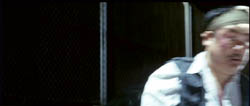
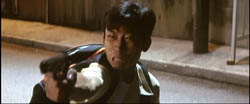
The next shot is the crucial one. Through a rain-speckled car windshield we see Lo fleeing.
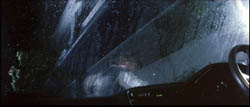
Why shoot from this fancy angle? It does two things at once. It tells us about the fleeing cop’s progress, continuing the action of the earlier shot of him, but it also puts us in the car, implying that the next phase of the action will take place here, rather than on the street. And so it does:
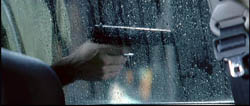
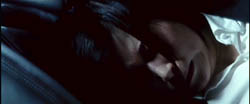
The wounded gunman staggers against the car, and again, instead of seeing his progress from the outside, we’re in the car. We don’t need to see his face, only the gun: director To films the danger. This shot expands on the previous one, keeping us in the front seat, and then gives us new information. The camera tilts diagonally to the policewoman crouching below the window.
The suspense is heightened when To cuts back to the pistol, bumping along the glass.
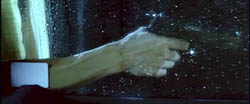
Will the gunman look inside the car? The movement of his arm is continued smoothly in a new angle:
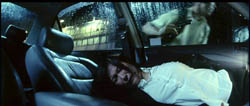
….as he rushes off to the right in pursuit of Lo. Director To gives us both action and reaction in the same concise shot. The policewoman sobs in relief, and this sub-sequence ends with a pause on her.
The sequence has broader implications as well, since this officer has been suspecting all along that Lo has lost his pistol (which he has). Now she has lost hers. After the smoke has cleared, Lo strolls back to her, and the shot echoes the earlier shots taken through the windshield.
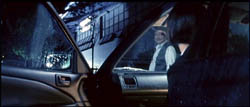
The irony dawns on her–in the heat of battle, it’s easy to lose your weapon–as she glances down at her discarded gun and retrieves it.
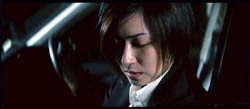
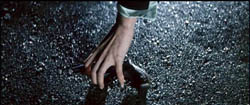
This sequence couldn’t have attained such precision if it were filmed with several cameras snatching shots, hoping to get something; nor with shoot-and-protect coverage. The passage is conceived cut to cut, in the director’s head. Each shot makes one or more points succinctly and leads us crisply to the next bit of action. When I asked Mr. To about the shot of Lo fleeing, seen through the windshield, he seemed surprised that I’d wonder. “Of course! You have to let people know they’ll see her in the car.”
Not back to the future, but ahead to the past
From DB:
Whatever you think of his films, Steven Soderbergh keeps Hollywood lively. Anybody who can remake both Solaris and Ocean’s Eleven has to attract your attention. He’s created at least three films I admire: Out of Sight (brilliant effort at a novelistic structure onscreen); The Limey (but I wish it were longer); and The Underneath (underrated, especially by its director).
So when Brian Rose and Paul Ramaeker sent me “You Can Make ‘Em Like They Used to,” by the ever-reliable Dave Kehr, I had to offer my two cents. You may want to check it before it evaporates into the Times pay-for-access archive. In a nutshell, Soderbergh’s The Good German is the most thoroughgoing effort by an American director to reproduce the look and feel of a 1940s movie. For me, Dave’s piece raises a lot of intriguing questions about how accurately you can reproduce an earlier style today.
RetroClassicism
During the production Mr. Soderbergh was committed to remaining as true as possible to the technique of the era. By reproducing the conditions of an actual studio shoot from the late 1940s, he hoped to enter the mind of a filmmaker like Mr. [Michael] Curtiz, to explore the strengths and limitations of a classical style that has now largely been lost.
This project hooks up with some arguments I made in The Way Hollywood Tells It. For one thing, I suggested that the overall “classical” style of Hollywood, founded on a certain conception of cinematic storytelling that emerged around 1917, hasn’t been abandoned, even in the most craven items we find in our multiplexes. But of course more local changes in style, shifts in particular technical devices of camerawork or lighting or editing, have come and gone. Another book I worked on, with Janet Staiger and Kristin Thompson, The Classical Hollywood Cinema, tries to trace some of the stylistic variations within the classical tradition. We covered topics like the development of deep-focus cinematography in the 1940s–just the sort of period-based technical choices that Soderbergh is trying to recapture.
Another theme of The Way is interestingly confirmed by Dave’s article. Some historians have argued that we’ve entered a “post-classical” era in which classical storytelling principles have been abandoned. I tried to show that in fact many of our filmmakers, like Cameron Crowe and Martin Scorsese, have the utmost admiration for the studio filmmaking tradition and define themselves as heirs and continuers of it. Spielberg said that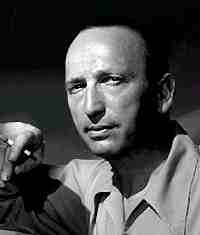 he’d like to be the Victor Fleming of our era; now Soderbergh has a new model.
he’d like to be the Victor Fleming of our era; now Soderbergh has a new model.
“I often think I would have been so happy to be Michael Curtiz [on right],” Mr. Soderbergh said. Mr. Curtiz, the contract director, made more than 100 films for Warner Brothers, including Casablanca and Yankee Doodle Dandy , between his arrival in Hollywood from Hungary in 1926 and his death in 1962. “That would have been right up my alley,” Mr. Soderbergh said, “making a couple of movies a year of all different kinds, working with the best technicians. I would have been in heaven, just going in to work every day.”
Today most directors carry forward the basic premises of the overall classical style quite spontaneously. A few do so in fuller awareness of that tradition, and several of those think about how they can enlarge, deepen, vary, or otherwise add to the heritage that they respect. Evidently The Good German is an example of this last tendency.
Through a Ground Glass Darkly
Take a deep breath. Some gearhead stuff coming. But interesting gearhead stuff.
“We set up our little guidelines,” [Soderbergh] said. For one, he banned the sophisticated zoom lenses that make life easier for today’s cinematographers, returning to the fixed focal-length lenses of the past. “I did some research and found some script continuities for a couple of Michael Curtiz films,” he recalled, referring to records of the lens and exposure used in every shot, in case retakes were necessary. “I found that he restricted himself to at most five lenses, usually three or four. I talked to Panavision, and they happened to have some older lenses that they’d made that didn’t have all the new coatings on them and also were a focal length that isn’t really used anymore. One of them was a 32 millimeter, a wide-angle lens that nobody uses anymore but was one that Curtiz used a lot.”
Wide-angle lenses have short focal lengths. As the name implies, they take in a wider field of view than lenses of longer focal lengths. They tend to distort vertical lines and make faces look puffy, so they weren’t recommended for medium-shots or close-ups. That was a task for lenses of “normal” lengths. It’s an interesting fact of film history, though, that over time the conception of a normal lens has changed.
In the silent era, the most commonly used lens seems to have been the 50mm, the classic “two-inch” lens. It was taken to be close to normal human vision. But by 1950, 35mm had become the default lens. Why? This wider-angle lens could be used easily on location and in the smaller sets mandated by wartime restrictions. Improvements in lighting, lens coatings, and film stock made the lens of short focal length more feasible. The Good German is set in the late 1940s, and Soderbergh has plugged into a general trend of filmmaking of that time
These lenses allowed directors to stage in greater depth, pushing foreground planes quite close to the camera and distant planes quite far back. And all the scene’s components could be in reasonable focus. After Citizen Kane, The Little Foxes, Ball of Fire, The Maltese Falcon, and How Green Was My Valley (all 1941) showcased a range of deep-focus possibilities, many cinematographers developed wide-angle styles.
They believed that the greater depth of field enhanced both realism and pictorial beauty.
Frank Planer: For Criss Cross (1949): “To give this picture added realism through photography, we filmed every scene with the 30mm lens to carry a wire-sharp depth of focus throughout the frame.” (Jack Taylor, “Dynamic Realism,” International Photographer 20, 9 (September 1948), 6.)
Russell Metty: Used 30mm lens at f/2.3 throughout Arch of Triumph (1948). (Herb A. Lightman, “‘Triumph’ in Low Key,” American Cinematographer 28, 5 (May 19447), 167.
Robert Surtees: For Act of Violence (1949), claimed to shoot all scenes with a 28mm lens “in order to carry focus and give more interesting compositions.” (Surtees, “The Story of Filming ‘Act of Violence,'” American Cinematographer 29, 9 (August 1948), 282.)
Ted McCord: For Johnny Belinda (1948), used 28mm lens almost entirely, even for medium-shots. (Herb A. Lightman, “‘Johnny Belinda,’ American Cinematographer 29, 10 (October 1948), 339.)
Many years later Stanley Cortez recalled that he had used a 30mm lens heavily for The Magnificent Ambersons (1942). (American Film Institute Seminar no. 35 (Glen Rock, NJ: New York Times/ Microfilming Corp of America, 1977), 1242-1243.)
Here are some typical examples of late 1940s wide-angle shooting from The Little Foxes, 1941; Notorious, 1946; Caught, 1949, and T-Men , 1949.
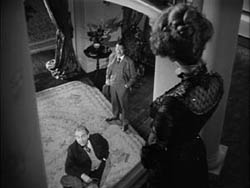
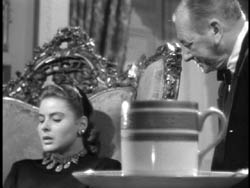
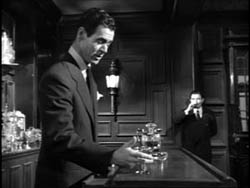
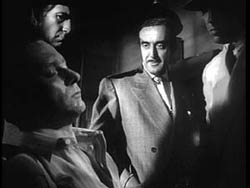
So given Soderbergh’s use of wide-angle lenses, will he try to reproduce the deep-focus look of the 1940s?
Coda for Ultimate Gearheads: The 32mm lens to which Curtiz refers was presumably the Cooke Speed Panchro lens, since I can’t find any other 32mm lens available at the time. (See Jackson J. Rose, American Cinematographer Hand Book and Reference Guide, 4th ed., American Society of Cinematographers, 1942, pp. 44-45.) Most cinematographers used the wide-angle lenses available from other companies, which were typically in the 25mm, 30mm, and 35mm ranges. Cooke, Leitz, and other firms also offered a 28mm length and a few still wider ones (25mm, 24mm, down to the Goerz 15mm!).
Another coda: The wide-angle style persisted in black-and-white filming into the 1950s and through the 1960s. It was hard to adapt to color in the 1950s, especially in the anamorphic formats like CinemaScope, but the emergence of faster color stocks made it more feasible in the 1970s. (I was reminded of this when Turner Classic Movies recently ran The Outfit (1973), with lots of neat depth shots.) The wide-angle look is occasionally revived today, notably in neo-noir, as here in The Usual Suspects.
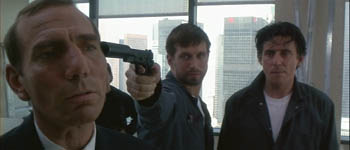
Light Waves and Sound Waves
To achieve effective depth of field, 1940s sets had to be lit at very high levels. This necessitated using the bright, hard illumination provided by arc lamps, as Gregg Toland did on Citizen Kane. Arcs, heavily used in the silent era, had been replaced by incandescent lamps in the late 1920s, because their hissing sound was picked up by microphones. “Inkies” were quieter. But once mikes became more selective, arcs were revived for Technicolor filming, and in the mid-1930s they were coming back into use for black-and-white shooting. Yet for The Good German…
They also used only incandescent lights, Mr. Soderbergh said.
Today’s actors aren’t accustomed to the blinding levels of set lighting of that period. So again, it’ll be very interesting to see if Soderberg’s inkies can provide enough depth of field to generate the flashy deep-focus of shots from the 1940s.
Wide-angle lenses also posed problems on the set. Since they took in a broader field, lighting equipment and other production gear had to be kept further back so it wouldn’t show in the frame. (Christopher Doyle told me that for the hyper-wide-angle shots of Wong Kar-wai’s Fallen Angels, crew members had to stand well behind the camera because anyone standing alongside it could wind up in the shot! Doyle’s lenses for that shoot had a focal length equal to 6.5mm!)
Moreover, 1940s wide-angle close-ups and medium-shots brought the camera within range of the microphone and other equipment. (You can hear the arc lights humming in a 35mm print of Citizen Kane, and other soundtracks of the period occasionally pick up camera or dolly noise.) Soderbergh again:
Where many, if not most, filmmakers use “body mikes” to capture the intimate whispers of dialogue, Mr. Soderbergh recorded his sound the old-fashioned way, through a boom microphone held just over the actors’ heads by a technician standing out of camera range.
“The rule was, if you can’t do it with a boom mike, then you can’t do it,” Mr. Soderbergh said. “Which was helpful to me because, in talking to the actors about this very externalized performance mode I was going to ask them to assume, it helped to be able to say, ‘You have to talk louder, you have to project more, because I’m not getting a good enough track.’ ”
I like the prospect of this whole approach, but I suspect that if 1940s filmmakers could’ve used wireless body mikes to cut camera murmur, they would have. Maybe this is a case when anachronism is welcome?
A Final Note: Staging
Dave Kehr and I have long been arguing against current filmmakers’ reliance on static staging and frantic cutting among close-ups. (Some readers took me to the woodshed on my criticism of The Departed on these grounds.) Dave and I enjoy the synthetic style of the mature sound cinema: long-take handling of actors crossing the frame and readjusting themselves in an integral space, punctuated by pointed closer views and that underrated workhorse, the spacious two-shot.
So you can practically hear Dave’s applause in this summary passage on Soderbergh’s choice of wide-angle lenses:
For audiences the shorter lenses mean a wider field of vision, expanding the camera’s range beyond the tight close-ups and two-shots that define today’s television-influenced filmmaking. With the wider range, groups of three, four or more characters can appear together on screen, minimizing the need for cross-cutting, which creates a different kind of interaction among the actors and a more expressive sense of the fictional space they inhabit.
Actually, the long lens can also create the sort of dynamic among bodies in space that we appreciate. A telephoto framing can show the interaction of several characters too. (Granted, they’re behaving in a curiously cardboardy-looking space.) We get this interaction in Altman’s 1970s films, but my favorite exponent is Hou Hsiao-hsien, who blocks his action as subtly in the distant long-lens views as classic directors did using more normal lenses.
Movies seldom turn out looking the way that the makers promised beforehand. Even the 1940s classics I litanized above don’t completely fit the cinematographers’ descriptions. Judging by the trailer for The Good German, the steep low angles and over-the-shoulder framings echo The Third Man more than, say, Jacques Tourneur’s Berlin Express.
And put aside all the fancy aggression of deep-focus. The big question is: Will Soderbergh dare to be simple as well? One production still seems promising.

I hope that Soderbergh has recognized that his mentor provided plenty of full shots with room for performers to breathe and move around. Such shots were as common, and as typical, in the 1940s as the suffocating compositions of noir. Recall this fluent passage from Mr. Curtiz’s noirish Mildred Pierce, in which characters cross the frame, shifting the compositional balance as the camera discreetly moves backward, inward, and sideways. Mildred and her husband move unobtrusively forward as the dramatic pressure rises–before it’s cut off by a crucial phone call from offscreen.
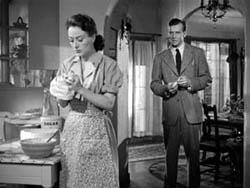
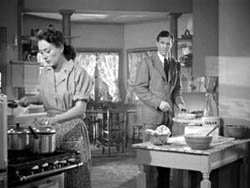

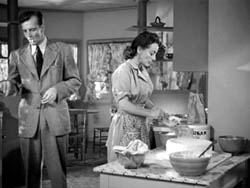
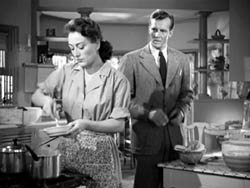
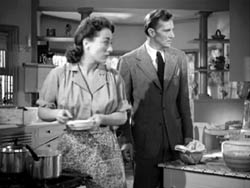
This staging technique is as characteristic of 1940s cinema as…well, as it is of 1930s and 1950s cinema. Let’s hope that some of it finds its way into The Good German. Can he really make ’em like they used to?
I have more comments, especially on Soderbergh’s fascinating remarks on changes in editing, but those are more appropriate to my next installment.
Addendum, 25 January
Owing to a slow and barren rollout, The Good German arrived in Madison last week. I caught it yesterday, so I thought I’d add this postscript.
It’s hard to appreciate as a straight film, it’s so dense and tightly wrapped in an air of pastiche. For the first time in my life, I felt the way students starting to study film tell me they feel: Noticing technique takes away from following the story. I found it hard to engage with the unfolding action because there was always some archaic technique obtruding–a trembling back-projection, a soft-edged wipe, or noirish lighting. I think audience involvement is also hurt by schematic plotting, with the Clooney character getting pretty regularly clobbered by bad guys.
So what about it as a pastiche? I think it fails. It’s cut a bit fast for the period (I clock it averaging about seven seconds per shot), but that’s not the real problem. The photography is too high-contrast for a studio film of that period; on the print I saw, the blacks were fairly rich, but the whites were blasted out and the grays were mostly gone. The editing of the fights is very modern, short and sharp and at some moments almost unreadable. On the whole, shots are closer and compositions less compact than in the sort of 1940s film that Soderbergh seems to be mimicking. These factors are probably due to the fact that he had to shoot in 1.85 and couldn’t stick to the 1.33 proportions of the newsreel-montage credits.
In my blog, I’d hoped that Soderbergh would revive the fluid crosswise staging of the period, but no such luck. Stand-and-deliver rules, with the over-the-shoulder framings and big reaction shots as prominent as in any movie today. Soderbergh also succumbs to the modern habit of ending a scene on a long-shot, which most directors of the time wouldn’t favor.
As for the voice-over narration. Soderbergh knows that the forties saw a lot of experimentation with this technique. But I don’t recall that his variant–each of the three main characters gets a stretch of voice-over in the beginning, middle, and end–has an equivalent at the time. When a 1940s film draws on more than one character’s voice-over, we’re given an overarching narrating situation to frame each one, such as the police interrogation of several witnesses, or the day’s boat trip of Letter to Three Wives. Here, the voice-overs aren’t framed in that way, so the result is more like the free-floating musings we get in The Thin Red Line or a Wong Kar-wai film.
There are some nice trouvailles, though. The lighting in the sewer scene is purty, and it was a clever idea to use an abandoned movie theatre for a rendezvous, though the geography of the space isn’t really exploited much. I enjoyed the transition from the credits’ 1.33 format (complete with dirty projector gate) to the 1.85 one: the first shot in 1.85 is a darkened airplane hanger whose open doorway approximates the squarer ratio. On the whole, though, The Good German seems to me even more dry and cerebral a project than Solaris, a sort of film-school exercise by the deepest-pocketed kid in the class. Fortunately, the Oceans 11 franchise pays for it, but I wish Soderbergh would go back to the less showy genre riffs of The Underneath and Out of Sight.
Borat Make Benefit Glorious Multinational of Murdoch
Kristin here–
For some reason, the November 10 issue of Entertainment Weekly ran a story right up front in their “Newsnotes” section as to whether Borat: Cultural Learnings of America for Make Benefit Glorious Nation of Kazakhstan would be a success based on its internet hype. By the time the magazine showed up in our mailbox early the week after the November 3 release, the film had spectacularly won the weekend. Won it despite being in only 837 theaters. Won it with an average $31,607 per screen average for a total weekend haul of $26,455,463. By the way, shortly before the release, Fox actually reduced the number of planned theaters, wary about the film’s dubious chances. (I swear I said at the time, what are they thinking?)
The film predicted by Variety to win the weekend,, The Santa Clause 3: The Escape Clause came in a respectable second on 3,458 screens, averaged $5,640 and totaled $19,504,038. Flushed Away was not far behind, on 3,707 screen, averaging $5,075 and totaling $18,814,323. It seems fairly obvious that the two family-oriented films split that audience, while the considerable non-family-oriented audience had one obvious choice.
This film was hyped to an extent that few $18 million movies are. A clip was posted on YouTube shortly before the release, as the EW article points out, and chat, photos, and reviews filled the internet. EW’s question was this: Would Borat suffer the fate of Snakes on a Plane? That film caused huge amounts of buzz in cyberspace but reaped somewhat disappointing ticket sales for a horror-thriller. The film’s worldwide box-office, $59,377,419 on a reported budget of $33 million, wasn’t great, but it wasn’t disastrous, either. I suspect DVD sales will be much higher and put the film in the black.
The semi-failure of Snakes has led to speculation, as in EW’s article, that maybe the internet isn’t as powerful a means of publicizing films as the studios hoped. Borat’s success demonstrates that we just plain don’t know yet. Probably in some cases, yes, in some cases, no—just as with other forms of publicity. EW assigns grades to films’ trailers. Maybe someday they’ll do the same for internet campaigns.
Sure, Borat was all over the internet, but it was also all over the other media. You had to be living in a lighthouse on Easter Island if you wanted to miss all the PR. Sasha Baron Cohen himself was everywhere, including the sidewalk in front of the White House, promoting the film. He wisely appeared as Borat rather than as himself, giving people beyond his relatively small existing fan base a vivid hint of what they could expect from the film. The hype fed upon itself as the regular print and broadcast media began to treat the film as news precisely because it was becoming ubiquitous—and because the colorful Cohen/Borat made for great infotainment.
Even as I was drafting this entry, boxofficemojo.com posted the estimates for the Friday-night box-office figures. Not surprisingly, the top three films of last weekend look set to become the top three films of this weekend. Borat’s percentage of drop between weekends will probably be pretty low, a sign of a film with good word-of-mouth in addition to hype. “Borat on a Plane?” EW asks. Clearly not.
I’m interested in the relationship between online interest and the success of films. When I say “online interest,” I mostly mean the many fan-created sites and chatroom discussion that range far beyond a studio’s own campaign in cyberspace. In The Frodo Franchise, I’ve got two chapters on the relationship of The Lord of the Rings to the online publicity, from official to highly unofficial. There the internet clearly made a difference and boosted the film’s success, for a variety of reasons. But for other films without a built-in fan base that break out and generate widespread interest in cyberspace—The Blair Witch Project being the most obvious exception—the case is not so clear.
The contrasting cases of Borat and Snakes on a Plane are fascinating, and I’m planning to write more about the subject when the DVD of the latter comes out on January 2 (complete with a “Snakes on a Blog” supplement). I’ll explore why the two met such different fates despite the apparent similarity of the build-up on the internet.













